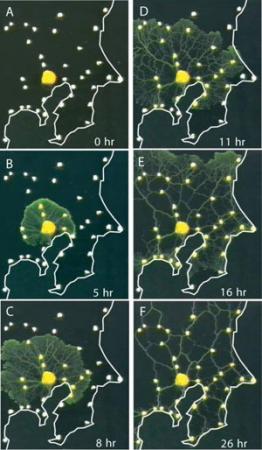专题:Science报道
人类的工程师能够从低等的粘液菌那里学到什么呢?据1月22日的《科学》杂志报道说,一则最近的实验提示,Physarum polycephalum(多头绒泡菌)这种凝胶性真菌样的霉菌可能真的能够指引人们改进技术系统,如:更为坚固耐用的电脑及移动性通讯网络。 这一启示来自一个日本和英国的研究团队所观察到的粘液霉菌将其与散在的食物源的连接方式图案几乎与东京的铁轨系统等同。

hysarum polycephalum的网络形成。
资料来源: 《科学》/美国科学促进会
Atsushi Tero及其同僚将燕麦片放置在一个潮湿的表面之上,其放置的各个点相当于东京周围的各个城市,并让Physarum polycephalum这种霉菌从中心向外生长。 他们看着该粘液菌进行自我组织、向外扩散并形成一种网络,其在功效、可靠性以及成本上都堪比真实世界的东京铁路网的基础设施。 研究人员能够捕捉到这种以一种有效率的方式与其食物源相连的适应性及生物学网络所需要的核心机制,并将其结合到一个数学模型之中。 由于该粘液霉菌已经经历了无数回的进化选择,因此这种基于其摄食习性的规则可以提供人们在现实世界应用中一种最有功效及适应性网络设计的途径。 Tero及其同僚说,他们的模型对改善诸如遥感器阵列、随建即连网路及无线网状网络等自我组织的网络的功效及降低成本等方面提供了一个起始点。 Wolfgang Marwan在一篇Perspective中对这些发现做了更为详细的解释。(生物谷Bioon.com)
生物谷推荐原始出处:
Science 22 January 2010:DOI: 10.1126/science.1177894
Rules for Biologically Inspired Adaptive Network Design
Atsushi Tero,1,2 Seiji Takagi,1 Tetsu Saigusa,3 Kentaro Ito,1 Dan P. Bebber,4 Mark D. Fricker,4 Kenji Yumiki,5 Ryo Kobayashi,5,6 Toshiyuki Nakagaki1,6,*
Transport networks are ubiquitous in both social and biological systems. Robust network performance involves a complex trade-off involving cost, transport efficiency, and fault tolerance. Biological networks have been honed by many cycles of evolutionary selection pressure and are likely to yield reasonable solutions to such combinatorial optimization problems. Furthermore, they develop without centralized control and may represent a readily scalable solution for growing networks in general. We show that the slime mold Physarum polycephalum forms networks with comparable efficiency, fault tolerance, and cost to those of real-world infrastructure networks―in this case, the Tokyo rail system. The core mechanisms needed for adaptive network formation can be captured in a biologically inspired mathematical model that may be useful to guide network construction in other domains.
1 Research Institute for Electronic Science, Hokkaido University, Sapporo 060-0812, Japan.
2 PRESTO, JST, 4-1-8 Honcho, Kawaguchi, Saitama, Japan.
3 Graduate School of Engineering, Hokkaido University, Sapporo 060-8628, Japan.
4 Department of Plant Sciences, University of Oxford, Oxford OX1 3RB, UK.
5 Department of Mathematical and Life Sciences, Hiroshima University, Higashi-Hiroshima 739-8526, Japan.
6 JST, CREST, 5 Sanbancho, Chiyoda-ku, Tokyo, 102-0075, Japan.







